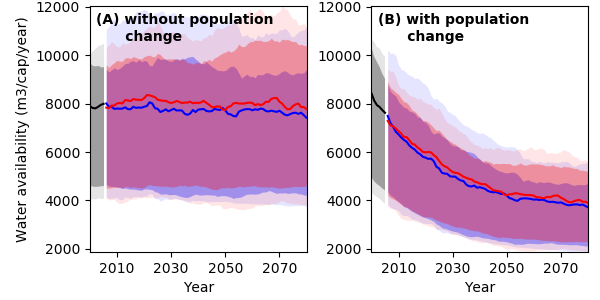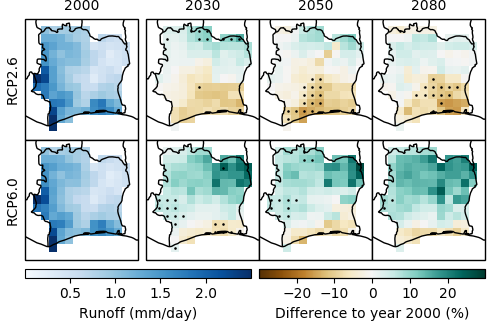Côte d’Ivoire: Water resources
Water shortage in Côte d’Ivoire has been an issue for decades and is likely to continue in the future. Several studies show that climatic changes in the country have resulted in a decrease in total precipitation amounts, a shift of the onset of the rainy season and an increase in the frequency and duration of droughts [20]–[22]. The first six months of 2019 recorded an average precipitation decrease of 28 % in the country, hence the lowest value compared to the average precipitation sums from the period 2014–2018 [19]. Especially rural communities in the northern part of Côte d’Ivoire suffer from recurring water shortages limiting their abilities to improve agricultural activities [19]. The increase in the frequency and intensity of droughts has also led to the loss of the second crop cycle among rice farmers [23]. Today, due to decreased precipitation amounts, many farmers must get by with one crop cycle, in some areas not even achieving a full one. However, not only rural but also urban areas experience the consequences of droughts: In 2018, Côte d’Ivoire’s second-largest city Bouaké was left without running water for three weeks as a result of reduced precipitation and decreasing water levels in the Loka reservoir which supplies 70 % of the city’s water [24]. The government used tanker trucks to provide emergency supplies of water, while parts of the population had to migrate temporarily.
Per capita water availability

Current projections of water availability in Côte d’Ivoire display high uncertainty under both GHG emissions scenarios. Assuming a constant population level, multi-model median projections suggest no change in per capita water availability over the country by the end of the century under either RCP (Figure 9A). Yet, when accounting for population growth according to SSP2 projections5, per capita water availability for Côte d’Ivoire is projected to decline by 55 % under both RCPs by 2080 relative to the year 2000 (Figure 9B). While this decline is primarily driven by population growth rather than climate change, it highlights the urgency to invest in water saving measures and technologies for future water consumption, in particular in the northern part of Côte d’Ivoire, given the already recurring water shortages in that region [19].
Spatial distribution of water availability

Projections of future water availability from precipitation vary depending on the region and scenario (Figure 10). Under RCP2.6, water availability will decrease by up to 20 % in parts of southern Côte d’Ivoire, with most models agreeing on this trend. The picture is different for RCP6.0: Model agreement is low except for a small patch in the western part of the country which is projected to gain up to 10 % in water availability.
5 Shared Socio-economic Pathways (SSPs) outline a narrative of potential global futures, including estimates of broad characteristics such as country level population, GDP or rate of urbanisation. Five different SSPs outline future realities according to a combination of high and low future socio-economic challenges for mitigation and adaptation. SSP2 represents the “middle of the road”-pathway.
References
[19] World Food Programme, “WFP Côte d’Ivoire Country Brief August 2019,” Rome, Italy, 2019.
[20] B. T. A. Goula, B. Srohourou, A. B. Brida, K. A. N ’zué, and G. Goroza, “Determination and Variability of Growing Seasons in Côte d’Ivoire,” Int. J. Eng. Sci. Technol., vol. 2, no. 11, pp. 5993–6003, 2010.
[21] N. Coulibaly, T. J. H. Coulibaly, Z. Mpakama, and I. Savané, “The Impact of Climate Change on Water Resource Availability in a Trans-Boundary Basin in West Africa: The Case of Sassandra,” Hydrology, vol. 5, no. 1, pp. 1–13, 2018.
[22] G. Mahe and J.-C. Olivry, “Variations des précipitations et des écoulements en Afrique de l’Ouest et centrale de 1951 à 1989,” Sécheresse (Montrouge), vol. 6, no. 1, pp. 109–117, 1995.
[23] FAO, “The Impact of Climate Change on Rice Production in Ivory Coast, a Challenge Faced by Smallholder Farmers,” 2017. Online available: http://www.fao.org/in-action/aicca/news/detailevents/en/c/878311 [Accessed: 18-Feb-2020].
[24] L. A. Sanogo and D. Esnault, “After Cape Town, Ivory Coast City Feels the Thirst,” Phys.org, 2018. Online available: https://phys.org/news/2018-04-cape-town-ivory-coast-city.html [Accessed: 18-Feb-2020].


